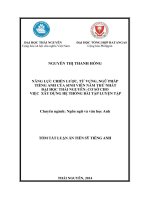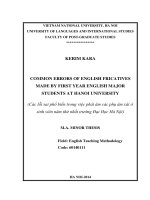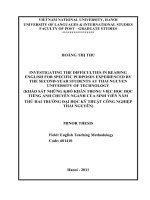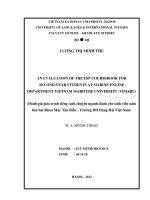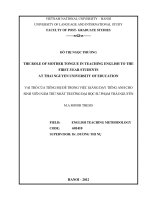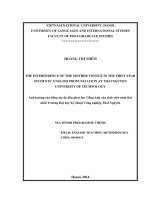Biên soạn nguồn tài liệu cho 3 kĩ năng nghe, nói và đọc tiếng Anh cho sinh viên năm thứ hai tại Đại học Thái Nguyên
Bạn đang xem bản rút gọn của tài liệu. Xem và tải ngay bản đầy đủ của tài liệu tại đây (2.61 MB, 229 trang )
THAI NGUYEN UNIVERSITY
Socialist Republic of Vietnam
BATANGAS STATE UNIVERSITY
Republic of the Philippines
1
Resource Materials for the Three Modalities of English Language
among Sophomore College Students
of Thai Nguyen University
A Dissertation Proposal
Presented to
The Faculty of Graduate School
Batangas State University
Batangas City, Philippines
In Partial Fulfillment
Of the Requirements for the Degree
Doctor of Philosophy
Major in English
By:
NGUYEN THI THU HOAI (JANE)
THAI NGUYEN UNIVERSITY
Socialist Republic of Vietnam
BATANGAS STATE UNIVERSITY
Republic of the Philippines
i
TABLE OF CONTENTS
TABLE OF CONTENTS i
LIST OF TABLES iii
LIST OF FIGURES iv
LIST OF FIGURES iv
CHAPTER
I. THE PROBLEM 5
Introduction 5
Statement of the Problem 11
Scope, Delimitation and Limitation of the Study 12
Significance of the Study 13
II. REVIEW OF LITERATURE 15
Conceptual Literature 15
Synthesis 49
Theoretical Framework 52
Conceptual Framework 54
Hypothesis 55
Definition of Terms 58
III. RESEARCH METHOD AND PROCEDURE 60
Research Design 60
Subjects of the Study 63
THAI NGUYEN UNIVERSITY
Socialist Republic of Vietnam
BATANGAS STATE UNIVERSITY
Republic of the Philippines
ii
Data Gathering Instrument 64
Data Gathering Procedure 67
Statistical Treatment of Data 68
IV. PRESENTATION, ANALYSIS AND INTERPRETATION
OF DATA 70
V. SUMMARY, CONCLUSIONS AND
RECOMMENDATIONS 110
Summary 172
Conclusions 182
Recommendations 184
BIBLIOGRAPHY 185
APPENDICES 191
A. Letter of Requests 192
B. Questionnaire 200
C. Documentation 220
CURRICULUM VITAE 228
THAI NGUYEN UNIVERSITY
Socialist Republic of Vietnam
BATANGAS STATE UNIVERSITY
Republic of the Philippines
iii
LIST OF TABLES
Table Title Page
1. Gender Profile of the Student Respondents 71
2. Parent's educational attainment 72
3. Place of Origin of the Student Respondents 74
4. Type of High School Profile 76
5. Level of students’ performance in the learning modality of reading 77
6. Level of student's performance in the learning modality of listening 80
7. Level of student's performance in the learning modality of speaking 82
8. Student's Performance in the Three Language Modality Test Groups
stratified according to the students’ profile variables 85
9 .Student Skills Employed in teaching the Basic English course 88
10. Student skills and Their Frequency of Use 90
11. Student Skills and Their Degree of Importance 91
12. Student's Performance in Three Language Modalities and 92
13. Teacher's Assessment 92
14. Base for the design of remedial exercises on the three modalities of
language 94
THAI NGUYEN UNIVERSITY
Socialist Republic of Vietnam
BATANGAS STATE UNIVERSITY
Republic of the Philippines
iv
LIST OF FIGURES
Table Title Page
1. Conceptual Paradigm of the study……………………………….…58
THAI NGUYEN UNIVERSITY
Socialist Republic of Vietnam
BATANGAS STATE UNIVERSITY
Republic of the Philippines
5
CHAPTER I
THE PROBLEM
Introduction
English as a versatile language is considered an amazing language.
Though it only ranked third in terms of the number of people using, still it
becomes the global language and declared as the “lingua franca” of the
world.
English language is spread through the demands of the business
sector, the academe, science and technology, and the diplomatic advocacy
of the espousing country. There are reasons identified why foreign
language learners need to learn English. First to be able to do business, to
be educated, to have a political alliance with, to be able to work or migrate
in America, for it is believed that proficiency in this language offers
attractive economic returns; uplifts the status of people in the third world
countries and English language serves as the major bridge towards greater
opportunities, understanding, academic progress and personal
development.
Being aware of the importance of the English language, government
agencies of most countries invest on English learning process. They have
set goals to improve the English proficiency of their component population
and impose programs through their educational system. This scenario is
THAI NGUYEN UNIVERSITY
Socialist Republic of Vietnam
BATANGAS STATE UNIVERSITY
Republic of the Philippines
6
not new to Vietnam and in fact the government has planned long term
national project in line with foreign languages. They set programs to uplift
the status not only of the English proficiency of its students but also the
competence of language teachers from primary to tertiary schools
Learners studying the foreign language basically develop
competence in speaking and writing with emphasis on grammar. There are
four ways in learning the English language. These include visual or seeing,
auditory or hearing, kinaesthetic or moving, and tactile or touching.
According to Bandler, R. et al. (1997) language learning involves
stimulation of multiple areas in the brain and that English language learning
to be effective cannot be just one dimensional which means that the more
faculties involved, the better and longer term is the learning. Understanding
or the cognitive skills are not always involved in the learning process which
explains the reason why adults tend to learn the second language slower
compared to the young.
English language has four modalities or skills and these include
reading, writing, speaking and listening. In learning the language, listening
comes first, followed by speaking, then reading and finally writing. There
are two ways how these four language modalities are related to each other.
These are the direction of communication the in or out and the method of
communication the spoken or the written.
THAI NGUYEN UNIVERSITY
Socialist Republic of Vietnam
BATANGAS STATE UNIVERSITY
Republic of the Philippines
7
Reading as a skill that helps man discover new things around him
serves as the foundation of learning of an individual. One acquires
knowledge and key concepts from the simplest to the most complex
through reading. It is considered vital in different learning situations. Ability
to read well provides opportunities for personal fulfilment and job success.
Further as an important skill in communication, reading is also a
multifaceted process. It involves word recognition, comprehension, fluency
and motivation. A person gets information from written letters and words
through reading. As a basic life skill, reading serves as a cornerstone for a
student’s success in school since all subjects require this skill for smooth
flow and transfer of learning. Total comprehension is the ultimate goal of
reading and integration of several or all subskills into a unitary skill during
reading is required. Reacting to authentic and real reading materials at
different levels of comprehension such as literal, interpretative, evaluative
critical and creative levels on the other hand are the ways integration is
achieved.
Listening as language modality is a very important area of
communication. There is an active involvement of individual in listening as
it involves a sender, a message and a receiver. Willingness of an individual
to participate completely in a communicative situation signifies good
listening. A number of processes also work on various levels in order to
THAI NGUYEN UNIVERSITY
Socialist Republic of Vietnam
BATANGAS STATE UNIVERSITY
Republic of the Philippines
8
produce an understanding of the incoming speech when good listeners
involve themselves with any type of spoken discourse.
In addition, listening is also important in the development of spoken
language proficiency. Means of interaction for the learner is provided by
spoken language likewise access to speakers of the language is essential
because learners must interact to achieve understanding. Good and proper
listening stimulates better communication in actual speaking situation.
Considered the productive skill in the oral mode is speaking. As a
communication skill a person is able to verbalize his thoughts and ideas
through speaking. A person may get involve into three kinds of speaking
situations such as interactive speaking, partially interactive speaking and
non- interactive speaking. In interactive listening, learners are engaged in
listening and speaking alternately, and through a conversation partner,
request to slow down conversation, clarification and repetition can be done
while in partially interactive speaking, the speaker may continue to deliver
his speech without interruption from the audience. Non-interactive
speaking can best manifest in speech recording or a radio broadcast. No
actual interaction happens.
Good speaking and listening as part of one process can help
learners to become successful in and out of school. It is believed that if
learner speaks well, ideas can be expressed clearly, likewise, if the learner
listens well more learning can be remembered. That is why integration of
THAI NGUYEN UNIVERSITY
Socialist Republic of Vietnam
BATANGAS STATE UNIVERSITY
Republic of the Philippines
9
these language modalities is considered important in classroom activities
to ensure learners’ participation in the use of language. This integration is
done for reinforcement of lessons. The integration of language modalities
can best be illustrated for instance in writing where it helps learner improve
their speaking skills, so as with reading where it facilitates learner’s writing
competence.
Improved competence in other modalities resulted from practice in
one modality. Teacher can project how learners can use language for a
variety of purposes if language modalities are integrated in curriculum and
instruction. Modalities can be integrated in instruction through lessons and
assessments more formally and informally for student’s language
production scaffolding. A technique that teacher can make use in
integrating modalities is through cooperative learning. Here learners can
work together by means of speaking and listening to each other and also
synthesizing information through reading and writing their ideas for
possible presentation.
In language modalities, learners encountered difficulties. In reading,
learners no longer enjoy reading as most of them are not fluent readers.
They have hard time understanding a given text as they have not acquired
necessary competence in reading or they lack comprehension in what they
are reading. They also encountered problems in pronunciation and
THAI NGUYEN UNIVERSITY
Socialist Republic of Vietnam
BATANGAS STATE UNIVERSITY
Republic of the Philippines
10
recognition of English words as well as learners’ inability to group words
into thought units.
In listening on the other hand, learners’ have to cope up with the
problems on vocabulary structures and rate of delivery. Learners also have
short attention span and lose focus due to lack of understanding of the
topic when it comes to listening to a native speaker of the language.
Learners also encountered problem relative to sound of the English
language. It takes sometimes for them to identify the sounds which are
unfamiliar to them.
The skill of speaking is considered a more difficult one. Learners
might be forced to speak a language which they are not comfortable with,
due to lack of understanding of its sentence structure, grammar and word
order. Though learners might have knowledge of words but their lack of
understanding of their proper use in sentences poses another problem.
As an English teacher teaching Basic English subjects among
second year college students of Thai Nguyen University, the researcher
has encountered the above mentioned problems in her classes, she is
interested to know students’ performance in the three modalities of
language namely; reading, listening and speaking to come up with a
resource material designed to reinforce students learning in Basic English.
Further, among Vietnamese college students in Thai Nguyen
University (TNU). In fact, there has not been an attempt to assess the
THAI NGUYEN UNIVERSITY
Socialist Republic of Vietnam
BATANGAS STATE UNIVERSITY
Republic of the Philippines
11
performance of students in the three learning modalities. It was clearly
shown that ELL classes would greatly benefit from learner-centered
English language pedagogy. Thus, it is perceived that this study can be
feasibly done among TNU students and would reveal basic and essential
information towards the effective English language teaching at their level.
Moreover, it will serve as basis for the author to formulate instructional
materials and pertinent student activities that would be responsive to the
needs of these students.
Statement of the Problem
This study determined the three modalities of learning English
among sophomore college students of Thai Nguyen University, Vietnam to
serve as basis for proposed resource materials.
Specifically, this sought answer to the following questions:
1. What are the characteristics of sophomore students with
reference to:
1.1. gender;
1.2. parents’ educational attainment;
1.3 students’ place of origin;
1.4. type of school attended (high school)
THAI NGUYEN UNIVERSITY
Socialist Republic of Vietnam
BATANGAS STATE UNIVERSITY
Republic of the Philippines
12
2. What is the performance of students in the following language
modalities?
2.1. Reading
2.2. listening
2.3. speaking
3. Are there significant differences on the performance of students
when grouped according to their profile variables?
4. How do teachers assess the performance of students in
the three language modalities?
5. Are there any significant differences between the performance of
students and the teachers’ assessment on the three modalities?
6. What resource materials may be prepared for each of the three
language modalities?
Scope, Delimitation and Limitation of the Study
This study focused on determining the performance of students in
the three modalities of language namely; reading, listening, oral or
speaking. Profiles of sophomore college students were also determined in
terms of gender, parents’ educational attainment, students’ place of origin
and type of school attended.
THAI NGUYEN UNIVERSITY
Socialist Republic of Vietnam
BATANGAS STATE UNIVERSITY
Republic of the Philippines
13
The descriptive method of research was used in the study applying
survey technique for teacher assessment of responses and teacher-made
test to determine students’ performance. Respondents of the study include
357 second year college English language students at some selected
colleges of Thai Nguyen University in Vietnam and 60 English teachers.
The survey questionnaire and teacher-made test served as the sources of
data for statistical analyses.
The study was limited to the profile variables of the sophomore
college students of TNU and the three modalities mentioned in the study as
well as to the responses of their respective English language teacher which
served also as other respondents of the study. The study was further
delimited to the year level of students indicated in the study and to the
specified subject area. The study did not include writing modality thus
became part of the delimitation of the study.
Significance of the Study
This study is significant to the following:
Students. Results of the study will provide students with rich
information and knowledge as regards to how they could enrich their
learning in the three modes of language. They will also benefit from the
resource materials developed.
THAI NGUYEN UNIVERSITY
Socialist Republic of Vietnam
BATANGAS STATE UNIVERSITY
Republic of the Philippines
14
Teachers. The study will benefit the teachers through the
experience gained in the utilization of the resource materials developed for
language modalities to their students. They would also be equipped with
materials that they can use to effectively improve their students language
performance.
Administrator. The results of the study will provide them a clear
basis for introducing the innovation that may come out of the study to their
respective schools.
Policy-makers. They will gain insights on the typical language
modalities prevalent among the students and would initiate advocacy and
policies pertinent to the findings of the study.
Researcher. The researcher will provide other teachers with useful
method and techniques that can improve their effectiveness in teaching
lessons. They can reduce disadvantages and teach students in a more
effective way.
Future Researcher. Other researchers may be interested in this
topic so they can conduct similar study
THAI NGUYEN UNIVERSITY
Socialist Republic of Vietnam
BATANGAS STATE UNIVERSITY
Republic of the Philippines
15
CHAPTER II
REVIEW OF LITERATURE
This chapter presents the relevant conceptual and research literature
which have bearing to the present study. These literatures provide
background to understand the present research. Presented also in this
chapter are the theoretical and conceptual frameworks, synthesis of the
study and definition of terms.
Conceptual Literature
The following concepts which focused on English language
instruction, student performance evaluation, English language modalities,
and instructional materials development were reviewed to substantiate the
study.
English Language Instruction. A new method of exploring the
English language is referred to as English language instruction or
education (englishlanguageinstruction.com). Lessons covered are relevant
to each student’s background and zero in on proper pronunciation,
conversational English, understanding of technical terms, phrases and
concepts. Classes are focused on students’ aspirations and relaxed
atmosphere is provided to students.
Language instruction is a practice of translating language policy that
has been articulated and founded in the language content standards since
THAI NGUYEN UNIVERSITY
Socialist Republic of Vietnam
BATANGAS STATE UNIVERSITY
Republic of the Philippines
16
the goal of a language curriculum which is a course or path that is
connected or integrated that lead to learning is that of fluency and literacy
and that curriculum materials should be chosen to fit on the language
policy (hrd.apec.org./index.php/language-curriculum and instruction).
Preparing multi-language citizens who can appreciate culture and
communicate with speakers of other languages is an issue considered
important in language instruction motivation for students to take other
languages even in secondary schools is difficult even in English speaking
economies.
In the 21
st
century citizens are expected to be proficient in multiple
languages for them to communicate in a variety of contexts. The benefits
an individual can enjoy in learning other languages may include improved
school performance, better problem-solving skills and higher self-esteem.
Learners on the other hand who have good command of their native
language and desire to learn for another language develop the global
language skill and may have the opportunity to work in a global context.
Language instruction or education is the teaching and learning of a
foreign or second language and may take place as a general school
subject in a specialized language school (www.wisegeek.com/what-is-
language-educationhtml). This is also referred to as the process of learning
a language, a teaching process of said language, as well learning a native
language for the first time or a second language. This is also commonly
THAI NGUYEN UNIVERSITY
Socialist Republic of Vietnam
BATANGAS STATE UNIVERSITY
Republic of the Philippines
17
used as an academic term as it deals with learning a second or additional
language beyond one’s native language.
Helping students become autonomous, independent, self- directed
language acquirers it is the purpose of language instruction. The two
identified goals of language instruction include: instruction should help
students understand how language is acquired or picked up; and language
instruction should help students learn where and how to get and use
comprehensible input, understandable English to read and listen to from
the outside world when they leave the room
(successfulenglish.com/2010/02purpose-of-language-instruction/).
The determining factors of the difference between the process of
language education and language acquisition are the teaching style used,
the age of students learning the language and whether the students are
developing first language in-depth skills or if there is an attempt to learn the
language. Most language education practices begin with vocabulary words
and verb conjugation principles while immersion style of teaching a
language is also utilized to encourage students to speak the new
language. Relative to this, whole language instruction is a viable method of
instruction(www.teachnology.com/theme/langarts/phonics/wholelang,
html). In this type of instruction, throughout the process instructor serves as
a guide. The world of reading is the focus of the learners whom language
THAI NGUYEN UNIVERSITY
Socialist Republic of Vietnam
BATANGAS STATE UNIVERSITY
Republic of the Philippines
18
practitioners encouraged for learners to apply their knowledge already
gained through their learning.
According to Anna Searle, British Council director for English
language, there is more to use English as the lingua franca of higher
education globally- as the most significant current trend in internationalizing
higher education. As in the case of the English language instruction at
Indiana University, it offers several programs for English Language
Development. Their Intensive English Program or EP for pre-matriculated
students with academic or professional goals has seven weeks session or
20 plus hours a week of instruction with seven levels of proficiency and no
credit (www. indiana.edu/dsls/eli/).
Further, for matriculated students admitted into the undergraduate
and graduate programs in this university, their English Language
Improvement Program or ELIP is an 8 week course that is 4 hours a week
composed of 5 to 6 topics and with credit units, while for students taking
the TEPAIC to become student assistants, the university offers the
Preparation for International Teaching. Special programs for students with
specific goal and English for Specific purpose programs are also offered.
The director of the department of education at Oxford Ernesto
Macaro added that more and more institutions across the world are using
English to teach academic subjects, spurred on by a desire to
internationalise their offer and their academic profile. Promising
THAI NGUYEN UNIVERSITY
Socialist Republic of Vietnam
BATANGAS STATE UNIVERSITY
Republic of the Philippines
19
instructional practices that are useful for defining best practices for
teaching English-language learners include: using visuals to reinforce
concepts and vocabulary; utilizing cooperative learning and peer tutoring;
use of students’ native language strategically when students are
floundering; providing opportunities for students to practice speaking
English in both formal and informal contexts throughout the day. In
addition, focusing on rich evocative vocabulary words during lessons so
students remained engaged and challenged is also included. For teaching
literary concepts the words can serve as vehicle (www.ncl d.org/students-
disabilities/ld-education-teachers/effective-instruction-for-Id-risk-English-
language-learners).
Moreover, English language instruction offers a wide range of
services to English language learners and their families particularly in Sta.
Cruz City Schools. English language development program is provided to
all English learners as well as access to the core curriculum
(www.sccs,stacruz,klz.ca,us/parents/students/English-language-
instruction.html). Access also to coursework, materials and instruction are
provided to learners. Comprehension is also a priority in terms of methods
of instruction to ensure progress in the levels of their proficiency in both
English and other core content areas.
English language as a lingua franca for education instructions
across the world from primary schools to universities, it is also the medium
THAI NGUYEN UNIVERSITY
Socialist Republic of Vietnam
BATANGAS STATE UNIVERSITY
Republic of the Philippines
20
of instruction utilized by university administrators. It also serves as a
facilitator to attracting international students as well as a way to improve
institution’s position in global university ranking as English improve
exchange of ideas and promote better relations between countries.
(www.timeshighereducation.co.uk/news/english-language-use-most
significant-internationalisation-trend-for-he/2013009article).
Learners of English as a second language in mainstream schools
where English is the language of instruction has the program where the
participants were advised to bring their home cultures into the classroom,
involving them in language-appropriate content-area instruction from the
beginning, and through integration of literature into the learning program
(García, et al. 2008). Further, the increasing number of English as
Second Language (ESL) students in the classrooms creates a strong need
for additional programs and services. While other teachers think that ESL
instruction requires a separate entity from standard-based instruction, most
teachers believed that they are intertwined with each other as stated in the
English TESOL Standards that teachers should know, understand, and use
evidence based practices and strategies related to planning, implementing,
and managing standards based on ESL and content instruction
(www.tesol.org).
Students’ Performance Evaluation. To examine, judge, appraise,
and assign value or worth refers to evaluation while performance refers to
THAI NGUYEN UNIVERSITY
Socialist Republic of Vietnam
BATANGAS STATE UNIVERSITY
Republic of the Philippines
21
the actions of carrying out or completing some functions, role, or obligation
(Horejsi, et al. 2002). In evaluation, the focus is on grades and may reflect
classroom components other than the course content and mastery levels
which include discussion, cooperation, attendance, and verbal ability
(Angelo, et al. 1993).
There are two types of student’s performance evaluations. These are
informal and formal evaluations. Ongoing feedback and suggestions by
instructor and takes place on a weekly and daily basis are features of
informal evaluations. Detailed review and comparison of the student’s
performance with evaluation criteria, standards, and learning objectives,
and happens at the end of each academic term which is dependent on
school policy or specialized circumstances are the components of formal
evaluations. Through a written report, the results of the evaluation were
placed into comprising of ratings assigned to the various items on the tool
used by school for their evaluation with a description in a form of narrative
about students’ strengths, abilities, special problems and deficiencies in
performance.
In order to determine if the student is making progress, to document
learning, to identify strengths and areas of performance that require special
attention and remediation, it is of significant importance for students’
performance to have continuous monitoring and frequent evaluations.
There are two purposes for the conduct of evaluation of student’s
THAI NGUYEN UNIVERSITY
Socialist Republic of Vietnam
BATANGAS STATE UNIVERSITY
Republic of the Philippines
22
performance. The first is that of summative to measure student progress or
achievement and the second is that of formative in order to provide feedback
to students to help them learn better (teaching.iub.edu./wrapper-big).
For students’ and teachers’ success, assigning grades to be part of
permanent records of students as well as giving feedback to students for
their improvement are needed. To give better chance to monitor students’
works and to improve their study habits to have better performance,
frequent tests and quizzes will be administered to them. To help students
also improve their learning, evaluation plans and activities should be
prepared.
There are suggested ways considered to have a fair and relevant
evaluation of student’s performance (www.washburn.edu/academics
College-schools/applied-studies/ departments/ social-work/sw-files about-
evaluating-students-performance-37pdf). These include: areas of
performance or competency that are truly important to the kind of task as
well as carrying out institution’s mission and goals are addressed; clear
criteria for student’s evaluation and objectives is possible to the degree;
students’ awareness of the evaluation criteria, standards and preferred
practices and outcomes at the beginning of the period of evaluation; and
compatibility of student’s performance to written standards and criteria,
rather than to some standards that are unstated or implied.
THAI NGUYEN UNIVERSITY
Socialist Republic of Vietnam
BATANGAS STATE UNIVERSITY
Republic of the Philippines
23
Providing continuous feedback and warnings or performance to
students prior to formal evaluation as well as providing realistic
performance criteria and standards fitted to students’ levels are also
included to have fair and relevant evaluation. Further, citing and describing
examples of performance through evaluation which form as basis for
ratings as well as giving consideration to the extenuating circumstances
that may influence the evaluation are also included. Level of performance
among students who demonstrated differences in motivation, competency,
knowledge, and specific skills are being identified and recorded in the
evaluative process likewise the nature and complexity of the assignments
given to students are taken into consideration in evaluation. Students’
growth and performance as well as students’ problems regarding need for
continued learning is also recognized in evaluation.
Green (1975) pointed out teachers need several types of learning
assessments as guide posts for instruction when instructing pupils and
these include initial assessments to determine the beginning level of
instruction, interim assessments to pace instruction and to provide
feedback to the learners and terminal assessment to determine the
ultimate achievement of the learners. Classified as formative evaluation are
initial and interim assessments as their major objective is that of helping
the learner. Instruction and learner are provided by formative evaluation
THAI NGUYEN UNIVERSITY
Socialist Republic of Vietnam
BATANGAS STATE UNIVERSITY
Republic of the Philippines
24
with feedback on his errors, his rate of progress and his level of
achievement related to the acceptable level of competence.
As an aid to students acquiring the necessary subject matter
competence and the requisite behaviours for each unit of learning,
formative evaluation is considered as the most important. Pupil’s progress
in terms of formative evaluation is often criterion-referenced indicating
minimum performances required before proceeding to new units of
instruction which is considered specific level of competence. In formative
evaluation, the norm- referenced approach may be utilized for the pupil’s
relative performance within the group is used rather than an established
competence level for assessment.
Under summative evaluation, terminal assessment is classified. A
general assessment of students’ achievement over an entire course or a
large unit of a course is its purpose. Uses of summative evaluation which is
either criterion or norm referenced include major basis for the course mark
and for determining the final level of students’ attainment. Considered
essential to good instruction is formative and summative evaluation of
which focus is given to summative evaluation by teachers rather than
formative evaluation.
Recognized as comprehensive, systematic and purposeful process,
that is an integral part of teaching and learning, evaluation must be based
on outcomes which represent goals for students which can also provide a



